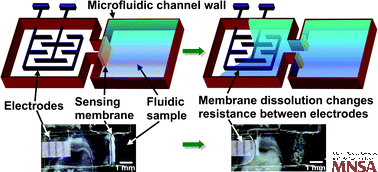We demonstrate a chemical and biological sensing mechanism in microfluidics that transduces chemical and biological signals to electrical signals with large intrinsic amplification without need for complex electronics. The sensing mechanism involves a dissolvable membrane separating a liquid sample chamber from an interdigitated electrode. Dissolution of the membrane (here, a disulfide cross-linked poly(acrylamide) hydrogel) in the presence of a specific target (here, a reducing agent -dithiothreitol) allows the target solution to flow into contact with the electrode. The liquid movement displaces the air dielectric with a liquid, leading to a change (open circuit to ~1 kΩ) in the resistance between the electrodes. Thus, a biochemical event is transduced into an electrical signal via fluid movement. The concentration of the target is estimated by monitoring the difference in dissolution times of two juxtaposed sensing membranes having different dissolution characteristics. No dc power is consumed by the sensor until detection of the target. A range of targets could be sensed by defining membranes specific to the target. This sensing mechanism might find applications in sensing targets such as toxins, which exhibit enzymatic activity.
